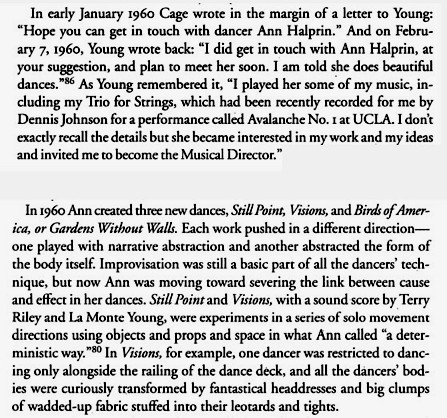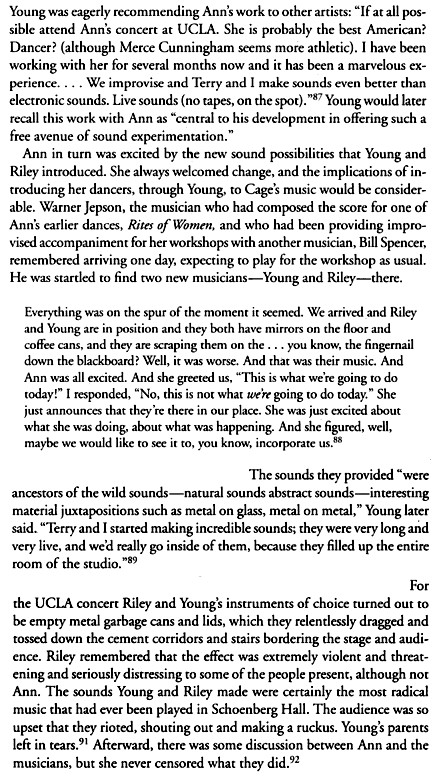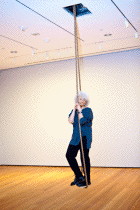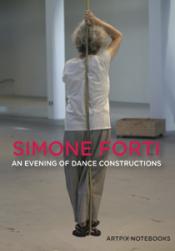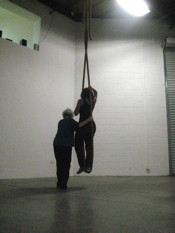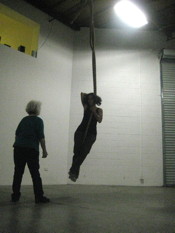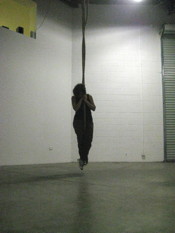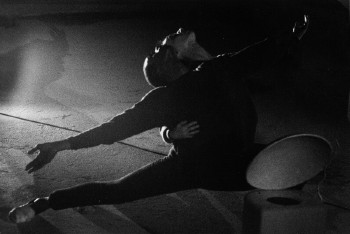> Studies > FAC-SIMILES > La Monte Young
early works of "noise" music / œuvres racines de la musique noise : — Studies —
NOISEseconde étude / Study 2 TWO SOUNDS (1960) |
|
Articles connexes / Other related articles : • LA MONTE YOUNG (Papers, articles) — read /lire • LA MONTE YOUNG (Works) — read /lire • LA MONTE YOUNG (Scores, writings) — read /lire • LA MONTE YOUNG (Interview 2003) — read /lire • THE WELL-TUNED PIANO (La Monte Young) — read /lire • BB DORIAN BLUES - TREE - YAM FESTIVAL (La Monte Young) — read /lire • DREAM HOUSE, ETC (La Monte Young) — bientôt / soon • Around La Monte Young : FLYNT, MACIUNAS — read /lire • LA MONTE YOUNG — An Anthology of Chance Operations (1963) — read /lire • LA MONTE YOUNG — Selected Writings (1959-1969) — read /lire |
Cette série explore les œuvres racines de la musique "noise" / This series is a study about early works of "noise" music. • RAINFOREST (David Tudor) - 1968-1973 — read /lire • BANDONEON (David Tudor) - 1966 • POEM FOR CHAIRS, TABLES, BENCHES, ETC (La Monte Young) - 1960 — read /lire • X FOR HENRY FLYNT (La Monte Young) - 1960 — read /lire •TWO SOUNDS (La Monte Young) - 1960 — read /lire • MUSIQUE BAROQUE - CONTREMUSIQUE, MACHINERIES ET SON/BRUIT - XVIIIeme siècle / BAROQUE MUSIC / COUNTER-MUSIC / ROUGH MUSIC / MACHINERIES AND NOISE — read /lire • ŒUVRES DE CHRISTIAN WOLFF - Faits, Actions, Collectifs — read /lire • STONES & STICKS (Christian Wolff) - 1971 — read /lire • MUSIQUES À INTENSITÉs (ETHNOMUSICOLOGIE) / MUSIC WITH LOUDNESS — (ETHNOMUSICOLOGY, POPULAR & FOLK MUSIC STUDIES) — read /lire • DRONES (Yoshi Wada) — read /lire • THE WOLFMAN (Robert Ashley) — read /lire |
Two Sounds (1960)(Edit)
| Il s'agit d'une autre composition [de La Monte Young] que nous avons pu écouté en Angleterre en 1964 lors de la saison de la compagnie Merce Cunningham au Sadler's Wells. Le titre de la chorégraphie et de l'œuvre est "Two Sounds". Le compositeur a fourni deux sons enregistrés sur deux bandes différentes à lire sur des magnétophones qu'il fallait faire démarrer en décalage durant la chorégraphie. Quand le premier son a débuté, on n'aurait jamais imaginer qu'un son aussi horrible pouvait exister. Ensuite lorsque le second son a été lancé, vous deviez admettre que vous vous étiez trompé. — (Cornelius Cardew) |
| ''English version — "One further composition reached England in 1964 when the Merce Cunningham Dance Company were at Sadler's Wells and the Phoenix Theatre for a season. Cunningham had choreographed a composition called 2 Sounds. The composer had provided two sounds on separate tapes, to be started at different points during the ballet. When the first sound starts you cannot imagine that any more horrible sound exists in the whole world. Then the second sound comes in and you have to admit you were wrong." - (Cornelius Cardew) |
1960, 2 Sounds, « friction sounds » (sons frottés), enregistrés
"Two Sounds" (1960) date d'une période où La Monte Young collaborait de manière très proche avec Terry Riley. Pour "Two Sounds" un des deux sons était fabriqué par la friction d'une boîte conserve sur un panneau de verre, et le second par la friction d'une baguette de percussion sur un gong : dans les deux cas le microphone était très proche de l'endroit de la friction, d'où la très forte intensité sonore. Les deux sons étaient enregistrés sur deux bandes magnétiques séparées qui devaient être jouées et démarrées à deux moments différents. Merce Cunningham a utilisé cette version pour sa chorégraphie "Winterbranch" à partir de 1964. [Auparavant, avant que John Cage choisisse en 1964 l'œuvre de la Monte Young pour "Winterbranch" de Cunningham, "Two Sounds" avait été jouée en 1961 pour une choréographie de SImone Forti (ou Morris, car elle était mariée à Robert Morris), "Accompaniment for La Monte’s 2 sounds and La Monte’s 2 sounds", créée au Chambers Street studio de Yoko Ono, et en 1960 avec la compagnie d'Anna Halprin.]
— Dave Smith, "Following a Straight Line: La Monte Young", Originally published in Contact no. 18 (Winter 1977-78), pp. 4-9. — http://www.users.waitrose.com/~chobbs/smithyoung.html
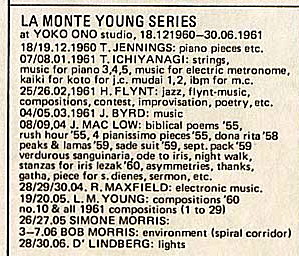 | Source : George Maciunas, "Diagram of Historical Development of Fluxus and Other 4 Dimentional, Aural, Optic, Olfactory, Epithelial and Tactile Art Forms", (Incomplete), annotated by Alison Knowles, 1973 (The Gilbert and Lila Silverman Fluxus Collection Archives in The Museum of Modern Art Archives) — [more info George Maciunas] — [more info Ono's Chambers Street Series] |
AUDIO & VIDEO
Simone Forti, "Accompaniment for La Monte’s 2 sounds and La Monte’s 2 sounds", 1961
excerpt of Simone Forti's "Dance Constructions", performed at the Box in Chinatown, Th 8/18/2011
| En 1959 et 1960, La Monte Young a été directeur musical de la compagnie de danse Anna Halprin** qui comprenait également d'autres compositeurs et collaborateurs tels Morton Subotnick, Pauline Oliveros, [Alan Hovhaness, David Tudor, Folke Rabbe] et Luciano Berio. John Cage avait mis en contact Anna Halprin avec La Monte Young. Ce dernier avait fait une première œuvre pour son "Birds of America or Gardens Without Walls", une œuvre déconnectée sans début, milieu, ni fin et sans durée établie. Terry Riley se rappelle d'une performance au Western Student Composers Symposium à la Brigham Young University à Provo Utah le 30 avril 1960. La Monte Young était assisté de Terry Riley pour les performances de "Two Sounds" avec la compagnie Halprin en avril 1960. Les instruments à utiliser n'étaient pas spécifiés dans la partition et l'œuvre a été jouée à la fois dans des versions avec bande magnétique et des versions performées en direct. "Two Sounds" a été joué avec "Poem for Chairs, Tables, Benches, etc." au Hertz Hall de Berkeley. — (Alburger, and Duckworth, 233) |
| ''English version — "Young served as music director from 1959-1960 for the Anna Halprin Dance Company, a progressive ensemble whose other composer-collaborators included Morton Subotnick, Pauline Oliveros, [Alan Hovhaness, David Tudor, Folke Rabbe], and Luciano Berio. Young had been put in touch with Halprin through Cage, and first worked with her on "Birds of America or Gardens Without Walls", a disconnected piece which avoided beginnings, middles, ends, and fixed time (!). Riley recalls a performance at the Western Student Composers Symposium at Brigham Young University in Provo, Utah on April 30, 1960. Young was assisted by Riley in his realizations for Halprin of 2 sounds (April, 1960). Instruments are not specified in the score, and the work has been performed in both taped and live versions. "2 sounds" has been performed within "Poem for Chairs, Tables, Benches, etc." at Berkeley's Hertz Hall. " — (Alburger, and Duckworth, 233) |
| ** "Depuis 1955, Anna Halprin accueillait également des créateurs de différents champs artistiques au sein de la « Dancers’ Workshop Company ». Elle y travaillait quotidiennement avec des acteurs tels que A.A. Leath ou John Graham, de nombreuses futures grandes chorégraphes telles que Simone Forti, et son mari d’alors le sculpteur Robert Morris, Trisha Brown, Yvonne Rainer, des musiciens tels que La Monte Young et Terry Riley, des cinéastes tels que Stan Brakhage, des poètes tels que Richard Brautigan… C'est en effet avec la première pièce de musique minimaliste de La Monte Young, le "Trio for Strings" de 1958, qu'Anna Halprin a dansé en 1960 sa pièce Birds of America or Gardens Without Walls. C'est chez elle que, la même année, Terry Riley a commencé à mettre au point la musique prérépétitive pour bande magnétique, Mescaline Mix. C'est dans l'immeuble qu'elle partageait avec le groupe de recherche de musique expérimentale San Francisco Tape Music Center que son groupe de danse a travaillé avec des compositeurs et musiciens tels que Pauline Oliveros et Morton Subotnick. C'est avec Luciano Berio et Cathy Berberian qu'elle a créé, en 1963, Esposizione, à l'opéra de Venise. En affirmant – en une approche similaire à celle de John Cage – « Tout mouvement est danse », elle introduit les gestes du quotidien dans le champ de la danse. Dès 1957, elle définit le concept de « Task / tâche » : dire aux danseurs ce qu’ils doivent faire, mais pas comment le faire, réalisant ainsi des partitions improvisées semi-ouvertes / semi-fermées. C’est chez elle que La Monte Young réalise deux de ses pièces majeures : "Two Sounds" et "Poem for Chairs, Tables and Benches", grâce aux sons obtenus par la friction d’objets à très haut niveau sonore sur les vitres ou sur le sol du studio d’Anna, produisant ainsi de très riches harmoniques qui lui permettent d’« entrer dans le son ». Chez Anna Halprin non plus, la musique n’est pas faite pour accompagner la danse, elle a sa vie propre, comme c’est le cas dans le travail que mènent en commun John Cage et Merce Cunningham. Pourtant, Anna Halprin s’éloigne davantage du champ pur et dur de la danse que ne le fait alors Merce Cunningham. Elle le dit elle-même : « C’est alors que je suis tombée de l’arbre de la danse et que je me suis approchée du champ de la performance. »" — (Jacqueline Caux, http://www.artpress.com/article/24/07/2013/exposition-plusmn-i96i—lexpansion-des-arts—du-19-juin-au-28-octobre-2013—museo-reina-sofia—madrid/29032#sthash.phO6ed2U.dpuf ) Cette même année Ann présente avec Simone Forti « Rites of Women », puis, en 1960, « Birds of America or Gardens Without Walls » sur une musique de La Monte Young. Au cours de ces deux années, La Monte Young sera en effet avec Terry Riley, l’un des deux co-directeurs musicaux du « San Francisco Dancers’ Workshop ». C’est la toute première pièce historique du courant musical minimaliste américain le « Trio for Strings » composé en 1958 à Los Angeles par La Monte Young, qui « accompagne » cette chorégraphie. Cette musique est composée à partir de sons longuement tenus alternant avec de plus ou moins longs silences. Ann travaillera également avec d’autres pièces de La Monte Young, telle « Two Sounds » qui est un des aboutissements des recherches menées pendant de longs mois auprès d’elle par ces deux musiciens, en faisant surgir des sons inouïs à très haut niveau sonore, à partir, entre autres, de la friction de différents objets tels que des canettes vides de bières, des poubelles, des tables, contre les vitres, les murs ou le sol de son studio de danse. C’est pour la performance d’Anna « The Four Legged Stool » que Terry Riley aborde en 1962 les principes de la musique répétitive avec la pièce « Mescalin Mix » composée à partir de boucles de bande magnétique. — (Jacqueline Caux, http://www.jacquelinecaux.com/jacqueline/fr/livres-anna-halprin-origine-performance.php ) |
Collaborations avec la compagnie Ann Halprin (1960)
- Stillpoint (or "Still Point"), 1960
Choreographed and Performed by: Anna Halprin, A.A. Heath, Hetty Mitchell
Music: Terry Riley, LaMonte Young
Lighting: Patric Hickey
Premiere: April 22, 1960, Schoenberg Hall, Los Angeles, CA
- Visions, 1960
Choreographed and Performed by: Anna Halprin, John Graham, A.A. Heath, Hetty Mitchell, Sandy Piezer
Music: Terry Riley, LaMonte Young
Lighting: Patric Hickey
Premiere: April 22, 1960, Schoenberg Hall, Los Angeles, CA
- Birds of America or Gardens Without Walls, 1960
Choreographed and Performed by: Anna Halprin and Dancers’ Workshop Company including John Graham, Daria Halprin, Rana Halprin, A.A. Leath
Music: LaMonte Young — "Trio for Strings" (1958)
Artistic Director: Jo Landor
Lighting: Patric Hickey
Location: International Avant-Garde Arts Festival, Vancouver, British Columbia
Références :
http://www.annahalprin.org/about_chronology_60.html
http://www.festival-automne.com/Publish/evenement/232/Halprin%209%20sept.pdf
| Je voulais faire des cercles sur le sol avec le gong pour obtenir des crissements. — (La Monte Young) | ||||||||||||||||||||||||||||||||||||||
| ''English version — "I would make circles with the gong on the floor and it would just screech" — (La Monte Young in Suzuki, 302) |
| Cela faisait un son peu comme un grincement de roue de train qui était répété durant 15 à 20 minutes, donnant l'impression de durer sur trois heures. Les auditeurs devenaient tout à fait angoissés. — (Hansen) | ||||||||||||||||||||||||||||||||||||||
| ''English version — "This made a sound not unlike a wagon wheel creaking, which was repeated for at least fifteen or twenty minutes and it seemed like three hours. Members of the audience became quite distressed." — (Hansen, 35) |
| "Two Sounds" : c'est vraiment une œuvre très radicale et très bruitée. Elle créait un tumulte lorsque nous la jouions. — (La Monte Young) | ||||||||||||||||||||||||||||||||||||||
| ''English version — "2 sounds : it's really a very radical piece, and very noisy, and created riots when it was first performed" — (La Monte Young in Duckworth, 231) |
| Dans une œuvre [Two Sounds] La Monte Young ne jouait pas du gong comme un instrument de percussion mais le traînait sur le sol en béton pendant que Terry Riley traînait de son côté une poubelle sur le mur. Cette performance divisait en deux le public dont une partie jurait haut et fort en entonnait l'hymne "The Star Spangled Banner" pour répliquer à l'agression. — (Strickland) | ||||||||||||||||||||||||||||||||||||||
| ''English version — "In one realization Young did not drum the gong but dragged it over the concrete floor, while Riley scraped a wastebasket against the wall. This particular performance led the audience to burst into both loud swearing and "The Star Spangled Banner" in self-defense" — (Strickland, Minimalism, 136) |
| J'ai fait une version opéra de chambre de "Poem". Et c'était assez déroutant. Il y avait quelqu'un qui faisait frire des œufs sur la scène, une fille qui qui dormait dans un sac de couchage dans une allée de la salle, une partie de jeu de billes dans un autre endroit, Phyllis Jones jouait Beethoven au piano, et la version pour bande magnétique de "Two Sounds" était diffusée sur les haut-parleurs, les étudiants de ma classe et de celle de Garner Rust déambulaient au milieu de la salle parmi le public et lisaient des livres d'analyse de musique, et de mon côté, je marchais au milieu du public en criant "vert" dans un seau. L'artiste Bruce Conner avait un criquet dans sa chaussure [un petit jouet métallique qui fait un bruit de cliquetis], et il se promenait aussi dans le public et récitait de la littérature. — (La Monte Young) | ||||||||||||||||||||||||||||||||||||||
| ''English version — "I did a chamber opera version of Poem. And that was absolutely wild. I had somebody on stage frying eggs, and a girl in the aisle was sleeping in a sleeping bag, and a game of marbles was going on somewhere, and Phyllis Jones was playing Beethoven at the piano, and my "2 sounds" was being played electronically on speakers, and my entire music appreciation class and Garner Rust's entire music appreciation class were walking though the audience reading from their music appreciation textbooks, and I was walking through the audience shouting "Green" into a bucket. And Bruce Conner, the artist, had a cricket in his shoe — you know, one of those that clicks — and he was walking through the audience and passing out literature" — (La Monte Young in Duckworth, 235) |
Références :
Extraits de / Quoted from :
- Alburger, Mark. "La Monte Young to 1960", In 21st Century Music, Volume 10, Number 3, March 2003)
http://21st-centurymusic.com/ML210303.pdf - Duckworth, William. "Talking Music: Conversations with John Cage, Philip Glass, Laurie Anderson, and Five Generations of American Experimental Composers". New York: Schirmer Books, 1995.
- Suzuki, Dean Paul. "Minimal Music: Its Evolution as Seen in the Works of Philip Glass, Steve Reich, Terry Riley, and La Monte Young, and Its Relation to the Visual Arts." Ph.D. dissertation, University of Southern California, May 1991.
- Strickland, Edward. "Minimalism: Origins". Bloomington: Indiana University Press, 1993.
Performances(Edit)
| — 1961/01/13 — the Cooper Union for the Advancement of Science and Art, NYC An evening of electronic opera and other musical essays in time, space, and sound, is produced by David Johnson. At the Cooper Union for the Advancement of Science and Art in New York in a program opening with "Cough Music" (a recorded montage of actual coughs nervously emitted by the audience during a New York ballet recital, electronically altered and rhythmically rearranged and magnified); "Two Sound"s (violin scrapings amplified to screeches); "Amazing Grace" (electronically scrambled Negro spirituals) and an opera, "The Peaceable Kingdom" by Dick Higgins, dedicated to the composer's brother Mark "murdered by Lumumba's racists" in the Congo, scored for speaking voices representing tropical animals, accompanied by electronically amplified sounds of three toy pianos. — Source : Year 1961 in "Music since 1900", ed. by Laura Kuhn and Nicholas Slonimsky, 6th Edition, Schirmer Books (publisher); New York, 2001, http://0-muco.alexanderstreet.com.libra.naz.edu/view/342197 Earle Brown archives (Earle Brown Music Foundation) : "Electronic Opera and Other Works concert" at Cooper Union 1961 featuring Dick Higgins, La Monte Young and others : "The Peaceable Kingdom by Dick Higgins; Computer Music, "Stacked Deck" by Dick Higgins and Richard Maxfield, etc. — Source : http://archivetest.earle-brown.org/printed-material-36 — http://archivetest.earle-brown.org/printed-material-16 Programme : "Grimaces", avec Dick Higgins (Requiem For Wagner, In Memoriam, The Peaceable Kingdom, Stacked Deck, costumes d’Alison Knowles), David Johnson (Oscillobagatelles), G. Matthews, Richard Maxfield (Cough Music, Pastoral Symphony, Amazing Grace), La Monte Young (Two Sounds) — Source : Olivier Lussac, Chronologie Performances 1961, http://www.artperformance.org/article-22018700.html |
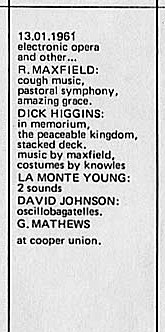 | Source : George Maciunas, "Diagram of Historical Development of Fluxus and Other 4 Dimentional, Aural, Optic, Olfactory, Epithelial and Tactile Art Forms", (Incomplete), annotated by Alison Knowles, 1973 (The Gilbert and Lila Silverman Fluxus Collection Archives in The Museum of Modern Art Archives) — [more info George Maciunas] |
| — 1961/05/26 & 27 — Loft Concerts, events and music works series at Yoko Ono studio (Chambers Street) — w/ Simone Forti (choregrapher), "Accompaniment for La Monte’s 2 sounds and La Monte’s 2 sounds". In "Accompaniment for La Monte's "2 sounds" and La Monte's "2 sounds,"" a twelve-minute recording by Minimalist composer La Monte Young plays as a dancer stands in a large loop of rope suspended from the ceiling; a second person turns the dancer around and around until the rope is completely wound up, and then releases. The piece ends when the recording stops. — Source : MOMA, Performance Exhibitions Series, Special Exhibitions Gallery, 2009, http://www.moma.org/visit/calendar/exhibitions/867 In 1961, well before John Cage selected 2 sounds for Merce Cunningham’s dance “Winterbranch” in 1964, seminal choreographer Simone Forti had created “Accompaniment for La Monte’s 2 sounds and La Monte’s 2 sounds,” which she premiered on the solo concert La Monte had invited her to perform at Yoko Ono’s Chambers Street studio. — Source : http://www.melafoundation.org/LYrecscat.html In the spring of 1961 Simone Forti presented a program titled Five Dance Constructions and Some Other Things in a concert series organized by her friend, composer La Monte Young, at the New York loft studio of Yoko Ono. These radically new dances created circumstances for the performers' direct, non-stylistic actions. Each of the pieces was performed in a different place in the loft, with the audience moving from location to location to view them. Some of the pieces required elementary structures - a hanging rope, rectangular wooden boxes - which were placed throughout the loft like a sculptural installation. This piece is an accompaniment for 2 sounds by La Monte Young, recorded together with Terry Riley in 1960 at the studio of Anna Halprin. 2 sounds consists of two continuous, very loud and complex sounds, one of very low and one of very high frequency, playing simultaneously. The accompaniment requires one rope and one person to ride in the rope. The rope forms a long loop which is fastened to the ceiling and hangs to within a foot of the floor. Ideally, the rope should be discretely positioned in the room, indicating that it is an accompaniment to the principal event, La Monte's music. The piece begins when a person places a foot into the loop of the rope and hoists herself up to stand there, like standing on a low swing. A second person starts the recorded sound, slowly turns the person in the rope round and round and round until the rope is completely wound up, and walks away. The sound fills the space. The rope unwinds, then rewinds on its own momentum, unwinds and rewinds until it becomes still. The unwinding finishes many minutes before the sound is over. The person remains hanging, standing in the loop of the rope and listening to the sound. — DVD release : Simone Forti, "An Evening of Dance Constructions", "Accompaniment for La Monte's 2 sounds and La Monte's 2 sounds". The soundtrack of La Monte Young's 2 Sounds has been re-mastered and the composer's notes accompany the video, http://www.microcinemadvd.co.uk/product/DVD/986/Simone_Forti.html |
 | Source : George Maciunas, "Diagram of Historical Development of Fluxus and Other 4 Dimentional, Aural, Optic, Olfactory, Epithelial and Tactile Art Forms", (Incomplete), annotated by Alison Knowles, 1973 (The Gilbert and Lila Silverman Fluxus Collection Archives in The Museum of Modern Art Archives) — [more info George Maciunas] |
| — 1962/03/23 —"New Dance Works", Maidman Playhouse, New York |
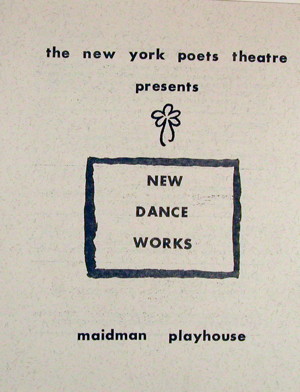 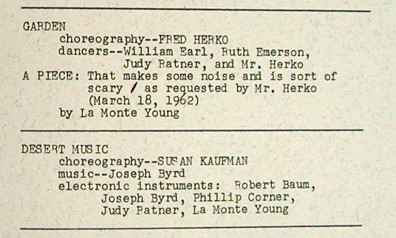 | "A Piece : That makes some noise and is sort of scary / as requested by Mr Herko (March 18, 1962)", by La Monte Young (supposed "Two Sounds" ?) — Source : http://pastelegram.org/features/282/event/259 |
| — 1962/09 —Wiesbaden Fluxus Festival, Hörsaal des Städtischen Museums, "Fluxus Internationale Festspiele Neuster Musik" |
 | Source : George Maciunas, "Diagram of Historical Development of Fluxus and Other 4 Dimentional, Aural, Optic, Olfactory, Epithelial and Tactile Art Forms", (Incomplete), annotated by Alison Knowles, 1973 (The Gilbert and Lila Silverman Fluxus Collection Archives in The Museum of Modern Art Archives) — [more info George Maciunas] |
| — 1963/05/11 & 12 —"Yam Festival", at the Hardware Poet's Playhouse, 115 West 54th Street, New York |
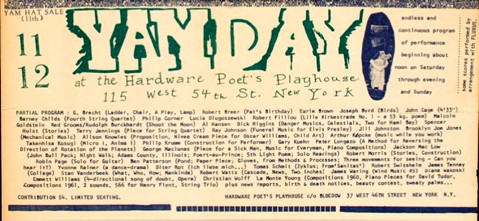 | Endless and continuous program of performance beginning about noon on Saturday through evening and Sunday Source : Walker Art Center Collection, — http://www.walkerart.org/collections/artworks/yam-festival-calendar — http://www.walkerart.org/collections?order=asc&order_by=Date+Acquired&type=Other+%2F+Miscellaneous — [more info Yam Festival (Tree by Allan Kaprow featuring La Monte Young, May 19 1963)] |
| — 1964/03/21 — First performance of "Winterbranch" with 'Two Sounds" by La Monte Young. Performed with Merce Cunningham and Dance Company. Hatford, Connecticut. Duration : 15mn Modern dance work in one act with choreography by Merce Cunningham, music by LaMonte Young, and design (set design, costumes & light design) by Robert Rauschenberg. Premiered 21 Mar. 1964 by the Cunningham Dance Company at Wadsworth Atheneum, Hartford, Connecticut, with Carolyn Brown, Merce Cunningham, William Davies, Viola Farber, Barbara Lloyd, Steve Paxton. It was conceived as a plotless work although its abrasive music and glaring lighting design suggest images of violence and destruction. The New York premiere was 4 Mar. 1965 at New York State Theater, and it was revived for Boston Ballet in 1974. It remained in Cunningham's repertory until 1976. — Source : The Oxford Dictionary of Dance, http://oxfordindex.oup.com/view/10.1093/oi/authority.20110803124216414 The concept for Winterbranch came from what Cunningham referred to as “facts in dancing.” Two such facts are the act of falling, and unless one stays on the ground, the subsequent act of rising. The dance began with Cunningham crawling slowly across the stage carrying a flashlight, followed by the dancers engaging in a series of falls, in both slow and fast motion, eventually clustering together to fall and rise as a cohesive group. Cunningham asked Rauschenberg to think of the lighting as if it were nighttime, with automobile lights flashing in faces, reminiscent of walking along a dark highway. Rauschenberg dressed the dancers in sweat suits and sneakers, with black paint under their eyes. La Monte Young’s music for the piece, entitled 2 Sounds, consisted of “the sound of ashtrays scraped against a mirror, and the other, that of pieces of wood rubbed against a Chinese gong.” — Source : Merce Cunningham Trust, http://www.mercecunningham.org/index.cfm/choreography/dancedetail/params/work_ID/83/ — Works choregraphed by Merce Cunningham |
| — 1964/06/12 — June 12-14, 1964. Paris, Théâtre National de l’Est Parisien. Performed with David Tudor and Merce Cunningham and Dance Company: "Winter Music" (electronic version) to Aeon; Conlon Nancarrow, "Rhythm Studies for Player Piano [sic] no. 1, 2, 4, 5, 6, 7" to Crises (tape); Erik Satie," Nocturnes" to Nocturnes (June 12, evening); Rune; Toshi Ichiyanagi, "Music for Piano" (electronic version) to Story; Erik Satie, "Trois morceaux en forme de poire" to Septet; Christian Wolff, "Suite" to Changeling (Tudor) (June 13, evening); "Cartridge Music (as Duet for Cymbal)" to Paired; John Cage "Concert for Piano and Orchestra" to Antic Meet; Morton Feldman, "Ixion" to Summerspace; La Monte Young, "Two Sounds" to Winterbranch (June 14, matinee); John Cage interviewed by John Ashbery (Ashbery 1964; Cage 1967o, 85n; Cage 1968c; Ephron 1964; Lenoir, J.-P. 1964). |
| — 1964/07/05 — July 5, 1964. Essen, Folkwang-Hochschule. Performed with Merce Cunningham and Dance Company: from John Cage "Music for Piano" to Suite for Five; La Monte Young, "Two Sounds" to Winterbranch; Toshi Ichiyanagi, "Music for Piano" (electronic version) to Story; Christian Wolff, "For Piano I" to Untitled Solo (Tudor). |
| — 1964/07/12 — July 12, 1964. Cologne, Opernhaus. Performed with David Tudor and Merce Cunningham and Dance Company: Toshi Ichiyanagi, "Music for Piano" (electronic version) to Story; Conlon Nancarrow, "Studies for Player Piano" to Crises (tape); La Monte Young, "Two Sounds" to Winterbranch; John Cage "Concert for Piano" and Orchestra to Antic Meet. |
| — 1964/07/23 — July 23-24, 1964. Dartington, Devon, England, Dartington Hall. Performed with David Tudor and Merce Cunningham and Dance Company: from John Cage "Music for Piano" to Suite for Five; Toshi Ichiyanagi, "Music for Piano" (electronic version) to Story; Conlon Nancarrow, "Rhythm Studies" to Crises (tape); Christian Wolff, "For Piano I" to Untitled Solo (Tudor) (July 23); John Cage "Cartridge Music (as Duet for Cymbal)" to Paired; John Cage "Concert for Piano and Orchestra" to Antic Meet; Erik Satie, "Trois morceaux en forme de poire" to Septet; La Monte Young, "Two Sounds" to Winterbranch (July 24). |
| — 1964/07/27 — July 27-August 1, 1964. London, Sadler’s Wells Theatre (Rosebury Avenue). Performed with David Tudor and Merce Cunningham and Dance Company: from John Cage "Music for Piano" to Suite for Five; Toshi Ichiyanagi, "Music for Piano" (electronic version) to Story; Conlon Nancarrow, "Rhythm Studies" to Crises (tape); Christian Wolff, "For Piano I" to Untitled Solo (Tudor) (July 27-28); John Cage "Concert for Piano and Orchestra" to Antic Meet; Bo Nilsson, "Rörelser, Slagfigurer, Kvantiteter" to Night Wandering (Tudor); Erik Satie, "Trois morceaux en forme de poire" to Septet; Christian Wolff, "Music for Merce Cunningham" to Rune (July 29-30); John Cage "Atlas Eclipticalis" with "Winter Music" (electronic version) to Aeon; Conlon Nancarrow, "Rhythm Studies" for Player Piano (collage arranged by Cage) to Cross Currents (first performance of the dance); Erik Satie, "Nocturnes" to Nocturnes; Christian Wolff, "Suite" to Changeling (Tudor) (July 31); John Cage "Cartridge Music (as Duet for Cymbal)" to Paired; Morton Feldman, "Ixion" to Summerspace; Erik Satie, "Nocturnes" to Nocturnes; La Monte Young, "Two Sounds" to Winterbranch (August 1, matinee); John Cage "Cartridge Music (as Duet for Cymbal)" to Paired; Morton Feldman, "Ixion" to Summerspace; Toshi Ichiyanagi, "Music for Piano" (electronic version) to Story; La Monte Young, "Two Sounds" to Winterbranch (August 1, evening). — (Barnes, C. 1964c; Bland 1964a; Buckle 1964a; Buckle 1964b; Cardew 1964; Clarke, M. 1964; Daily Mail 1964; Hope-Wallace 1964; Mellers 1964c; New Statesman 1964; Porter, A. 1964a; Porter, A. 1964b; Roberts, N. 1964; Spectator 1964; Time 1964b; Times 1964a; Times 1964b; Times 1964d; Times 1964e; Times 1964f) |
| — 1964/08/05 — August 5-22, 1964 (evenings). London, Phoenix Theatre (Charing Cross Road). Performed with David Tudor and Merce Cunningham and Dance Company: John Cage "Concert for Piano and Orchestra" to Antic Meet; Morton Feldman, "Ixion" to Summerspace; Bo Nilsson, "Rörelser, Slagfigurer, Kvantiteter" to Night Wandering (Tudor); Erik Satie, "Trois morceaux en forme de poire" to Septet (August 5-8); Field Dances; Toshi Ichiyanagi, "Music for Piano" (electronic version) to Story; Conlon Nancarrow, "Rhythm Studies" to Crises (tape); Christian Wolff, "Music for Merce Cunningham" to Rune (August 10-13); from John Cage "Music for Piano" to Suite for Five; La Monte Young, "Two Sounds" to Winterbranch; Conlon Nancarrow, "Rhythm Studies for Player Piano" (collage arranged by Cage) to Cross Currents; Erik Satie, "Nocturnes" to Nocturnes (August 14-15, 17-18); John Cage "Cartridge Music (as Duet for Cymbal)" to Paired; John Cage "Concert for Piano and Orchestra" to Antic Meet; John Cage "Winter Music" (electronic version) to Aeon; Christian Wolff, "Suite" to Changeling (Tudor) (August 19-22) — (Barnes, C. 1964a; Barnes, C. 1964b; Bland 1964b; Cardew 1964; Clarke, M. 1964; Goodwin, N. 1964; Spectator 1964; Time 1964a; Times 1964c). |
| — 1964/09/08 — 'September 8-14, 1964. Stockholm. Performed with David Tudor and with Merce Cunningham and Dance Company: Atlas Eclipticalis (percussion part) to Museum Event # 2 (September 8, Moderna Museet); videotaped for Swedish television: Concert for Piano and Orchestra to Antic Meet; Conlon Nancarrow, Rhythm Studies to Crises (tape); Bo Nilsson, Rörelser, Slagfigurer, Kvantiteter to Night Wandering (Tudor) (September 9, Moderna Museet); Royal Swedish Ballet with guest appearance by Merce Cunningham and Dance Company: La Monte Young, Two Sounds to Winterbranch (September 9, Opera); performed with David Tudor, first performance of Electronic Music for Piano (Tudor alone or with Cage?) and music by Sylvano Bussotti, Toshi Ichiyanagi, and Christian Wolff (September 10, Moderna Museet, New York-Kväll); Variations IV to Museum Event # 3; Tudor, Fluorescent Sound; Öyvind Fahlström, Fåglar i Sverige (September 14, Moderna Museet); Cunningham gave lecture-demonstration (September 10, Baletakademi) — (Dagens Nyheter 1964; Hähnel 1964; Hellqvist 1964; Johnson, Be. E. 1964). |
| — 1964/09/29 — September 29, 1964. Poznań, Paustwowa Opera. Performed with David Tudor and Merce Cunningham and Dance Company: Winter Music (electronic version) to Aeon; La Monte Young, Two Sounds to Winterbranch; Concert for Piano and Orchestra to Antic Meet. |
| — 1964/10/03 — October 3, 1964. Krefeld, Theater der Stadt Krefeld. Performed with David Tudor and Merce Cunningham and Dance Company: Winter Music (electronic version) to Aeon; La Monte Young, Two Sounds to Winterbranch; Erik Satie, Nocturnes to Nocturnes. |
| — 1964/10/08 — October 8, 1964. Scheveningen, Kurzaal. Performed with David Tudor and Merce Cunningham and Dance Company: Morton Feldman, Ixion to Summerspace; Toshi Ichiyanagi, Music for Piano (electronic version) to Story; Christian Wolff, Suite to Changeling (Tudor); La Monte Young, Two Sounds to Winterbranch. |
| — 1964/10/15 — October 15-16, 1964. Bombay, Bhulabhai Desai Auditorium. Performed with David Tudor and Merce Cunningham and Dance Company: Cartridge Music (as Duet for Cymbal) to Paired; from Music for Piano to Suite for Five; Toshi Ichiyanagi, Music for Piano (electronic version) to Story; La Monte Young, Two Sounds to Winterbranch (October 15); Concert for Piano and Orchestra to Antic Meet; Winter Music (electronic version) to Aeon; Conlon Nancarrow, Rhythm Studies to Crises (tape) (October 16). |
| — 1964/10/29 — October 29-30, 1964. New Delhi, Aifacs. Performed with David Tudor and Merce Cunningham and Dance Company: Concert for Piano and Orchestra to Antic Meet; Morton Feldman, Ixion to Summerspace; Christian Wolff, For Piano I to Untitled Solo (Tudor); La Monte Young, Two Sounds to Winterbranch (October 29); Toshi Ichiyanagi, Music for Piano (electronic version) to Story; Conlon Nancarrow, Rhythm Studies to Crises (tape); Bo Nilsson, Rörelser, Slagfigurer, Kvantiteter to Night Wandering (Tudor); Erik Satie, Trois morceaux en forme de poire to Septet (October 30). |
| — 1964/11/06 — November 6, 10-11, 1964. Tokyo, Sankei Hall, Otemachi. Performed with David Tudor and Merce Cunningham and Dance Company: from Music for Piano to Suite for Five; Toshi Ichiyanagi, Music for Piano (electronic version) to Story; Erik Satie, Trois morceaux en forme de poire to Septet (November 6); Variations IV to Cross Currents; Winter Music (electronic version) to Aeon; Toshi Ichiyanagi, Music for Piano (electronic version) to Story; Christian Wolff, Suite to Changeling (Tudor) (November 10); Cartridge Music (as Duet for Cymbal) to Paired; from Music for Piano to Suite for Five; Erik Satie, Nocturnes to Nocturnes; La Monte Young, Two Sounds to Winterbranch (November 11). |
| — 1964/11/12 — November 12, 1964. Kobe. Performed with David Tudor and Merce Cunningham and Dance Company: Concert for Piano and Orchestra to Antic Meet; Winter Music (electronic version) to Aeon; La Monte Young, Two Sounds to Winterbranch. |
| — 1965/03/04 — March 4, 6, and 7, 1965. New York, Lincoln Center for the Performing Arts, New York State Theater, Modern Dance in Repertory (March). In program shared with American Dance Theater and Juilliard Dance Ensemble, Merce Cunningham and Dance Company performed La Monte Young, Two Sounds to Winterbranch (March 4, evening, and March 6, matinee); Morton Feldman, Ixion to Summerspace (March 7, matinee and evening). |
| — 1965/03/28 — March 28, 1965. Philadelphia, Pennsylvania, YM-YWHA. Performed with Merce Cunningham and Dance Company: Variations IV to Cross Currents; Conlon Nancarrow, Rhythm Studies to Crises (tape); Erik Satie, Nocturnes to Nocturnes; La Monte Young, Two Sounds to Winterbranch. |
| — 1965/04/08 — April 8, 1965. New Brunswick, New Jersey, Douglas College: talk by Merce Cunningham with excerpts from La Monte Young, Two Sounds to Winterbranch; Conlon Nancarrow, Rhythm Studies to Crises (tape). |
| — 1965/04/12 — April 12, 1965. Ripon, Wisconsin, Ripon College. Performed with David Tudor and Merce Cunningham and Dance Company: Conlon Nancarrow, Studies for Player Piano Nos. 1, 2, 4, 5, 6, 7 to Crises (tape); La Monte Young, Two Sounds to Winterbranch; Variations IV and perhaps other music to Field Dances, Collage III and Cross Currents (performed as a continuous event) |
| — 1965/04/13 — April 13-14, 1965. Houston, Texas. Attended; performed Where Are We Going? and What Are We Doing? (April 13, University of Saint Thomas, Jones Hall); performed with David Tudor and Merce Cunningham and Dance Company, presented by the Houston Contemporary Arts Association: Conlon Nancarrow, Studies for Player Piano Nos. 1, 2, 4, 5, 6, 7 to Crises (tape); La Monte Young, Two Sounds to Winterbranch; Variations IV and perhaps other music to Field Dances, Collage III and Cross Currents (performed as a continuous event) (April 14, Music Hall) — (Ogg 1965; Roussel 1965). |
| — 1965/07/30 — July 30-31, 1965. Upper Black Eddy, Pennsylvania, Sundance. Performed with David Tudor and Merce Cunningham and Dance Company: Variations II (Tudor); 0'00" (Cage); Variations IV (Cage and Tudor) (July 30, concert performance); Music for Piano (Nos. 4-84, selection) to Suite for Five; La Monte Young, Two Sounds to Winterbranch; Variations V (July 31, dance performance) — (Miller, L.E. 2001). |
| — 1965/11/10 — November 10, 1965. Salt Lake City, Utah, University of Utah. Probably performed with David Tudor and Merce Cunningham and Dance Company: Music for Piano [1-84] to Suite for Five; La Monte Young, Two Sounds to Winterbranch; Variations IV to Collage III; Erik Satie, Nocturnes to Nocturnes. |
| — 1965/11/23 — November 23-28, 1965. Chicago, Illinois, Harper Theatre, Dance Festival. Performed with David Tudor and Merce Cunningham and Dance Company: from Music for Piano to Suite for Five; La Monte Young, Two Sounds to Winterbranch; Variations V (November 23); Morton Feldman, Ixion to Summerspace (version for two pianos); How to Pass, Kick, Fall, and Run (with electronic modifications by Tudor); Solo for Piano from Concert for Piano and Orchestra (Tudor) with WBAI (Cage) to Antic Meet (November 24); Field Dances/Collage III; La Monte Young, Two Sounds to Winterbranch; Bo Nilsson, Rörelser, Slagfigurer, Kvantiteter to Night Wandering (Tudor); Nocturnes (November 25); from Music for Piano to Suite for Five; How to Pass, Kick, Fall, and Run; Bo Nilsson, Rörelser, Slagfigurer, Kvantiteter to Night Wandering (Tudor); Nocturnes (November 26); Field Dances/Collage III; La Monte Young, Two Sounds to Winterbranch; Variations V (November 27, matinee); How to Pass, Kick, Fall, and Run, Variations V; Morton Feldman, Ixion to Summerspace (November 27, evening); Variations IV to Field Dances/Collage III; How to Pass, Kick, Fall, and Run; Solo for Piano from Concert for Piano and Orchestra (Tudor) with WBAI (Cage) to Antic Meet (November 28). — (Cage 1967o, 133n; Levy, B. 1965; Miller, L.E. 2001; Williams, M. 1965). |
| — 1966/02/03 — February 3-5, 1966. Beloit, Wisconsin, Beloit College, Avant-Garde Festival. Attended; gave concert-lecture including (presumably first) reading from Diary: How to Improve the World (You Will Only Make Matters Worse) 1965 (February 4, morning, Eaton Chapel); performed with David Tudor and Merce Cunningham and Dance Company: Music for Piano 4-84 to Suite for Five; La Monte Young, Two Sounds to Winterbranch (tape machines); How to Pass, Kick, Fall, and Run (alone) (February 4, evening, Field House). — (Cage 1967o, 3; Stocking and Stocking 1966). |
| — 1966/04/23 — April 23, 1966. New York, Brooklyn Academy of Music. Performed with Merce Cunningham and Dance Company (and presumably with David Tudor): Concert for Piano and Orchestra to Antic Meet; from Music for Piano to Suite for Five; La Monte Young, Two Sounds to Winterbranch — (Barnes, C. 1966a). |
| — 1967/04/19 — April 19-20, 1967. Lexington, Kentucky, University of Kentucky, School of Fine Arts, Festival of the Arts (April 5-22). Performed with Merce Cunningham and Dance Company: How to Pass, Kick, Fall, and Run (with David Vaughan); Variations V; La Monte Young, Two Sounds to Winterbranch (April 19, Memorial Coliseum); lectured (April 20, Guignol Theatre). — (Werle 1967). |
| — 1967/04/23 — April 23, 1967. Columbus, Ohio State University, Battelle Auditorium, organized by School of Music and Department of Dance. Performed with David Tudor, Gordon Mumma, David Vaughan, and Merce Cunningham and Dance Company: from Music for Piano 4-84 to Suite for Five (with Tudor); How to Pass, Kick, Fall, and Run (with Vaughan); also La Monte Young, 2 Sounds to Winterbranch (Mumma?). |
| — 1968/07/15 — July 15-20, 1968. México, D.F., Teatro de Bellas Artes, Programa Cultural de la XIX Olimpiada, Festival Internatiocal de las Artes, presented by the Instituto Nacional de Bellas Artes. Performed with Gordon Mumma, David Tudor and Merce Cunningham Dance Company: from Music for Piano 1-84 to Suite for Five, Tudor, Rainforest to Rainforest (Tudor), Mumma, Mesa to Place (Mumma and Tudor) (July 15; July 16; July 20, evenings); How to Pass, Kick, Fall, and Run; Toshi Ichiyanagi, Activities for Orchestra to Scramble; La Monte Young, Two Sounds to Winterbranch (July 18, evening; July 19, late afternoon); Variations IV to Field Dances; David Behrman, … for nearly an Hour… to Walkaround Time; Bo Nilsson, Rörelser, Slagfigurer, Kvantiteter to Night Wandering (Tudor); Pierre Schaeffer and Pierre Henry, from Symphonie pour un homme seul to Collage III (July 19, evening; July 20, late afternoon). |
| — 1970/01/08 — January 8-12, 1970. New York, Brooklyn Academy of Music, [Brooklyn] Festival of Dance. Performed with Merce Cunningham and Dance Company (January 5-16): first performances of Cheap Imitation (piano) to Second Hand (January 8, 9, 12, Cage); other performances David Behrman, ... for Nearly an Hour... to Walkaround Time (January 8); Conlon Nancarrow, Studies for Player Piano No. 1-2, 4-5, 6-7 to Crises (tape); David Tudor, Rainforest to Rainforest (January 9); Pauline Oliveros, In Memoriam Nikola Tesla, Cosmic Engineer to Canfield; La Monte Young, 2 Sounds to Winterbranch; Christian Wolff, For 1, 2 or 3 People to Tread (January 10); Gordon Mumma, Mesa to Place; David Tudor, Rainforest to Rainforest (January 12). — (Cunningham, M. 1982b, 181-182; Terry, W. 1970). |
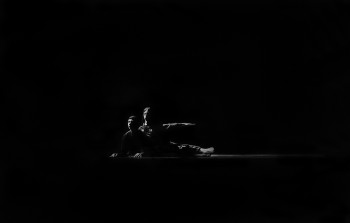 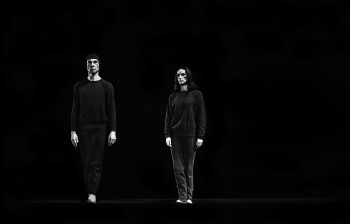 | Photos : James Klosty http://www.nancydalva.com/2012/10/cunninghams-winterbranch-photos-from.html The cast in its entirety for this January 1970 performance was: Merce Cunningham, Carolyn Brown, Sandra Neels, Jeff Slayton, Valda Setterfield, and Chase Robinson. Photo 1 : Merce Cunningham and Sandra Neels Photo 2 : Merce Cunningham and Carolyn Brown |
| — 1970/03/07 — Early March-March 7, 1970. Pittsburgh, Pennsylvania. Organized by Pittsburgh Dance Council. During one-week residency (with the company: lecture-demonstrations, open rehearsals) performed with Merce Cunningham and Dance Company: Events (during the week on variouys locations), lecture-demonstration including La Monte Young, Two Sounds to Winterbranch (March 6, Carnegie Music Hall); open rehearsal (March 7, afternoon, Syria Mosque); Cheap Imitation (piano) to Second Hand; David Tudor, Rainforest; Christian Wolff, music to Tread (March 7, evening, Syria Mosque, concluding concert). — (Beaman 1970; Miller, Do. 1970). |
| — 1976/03/15 — March 15-20, 1976. Sydney, New South Wales, Opera House, Opera Theatre. Performed with David Tudor, Takehisa Kosugi, and Merce Cunningham and Dance Company: Christian Wolff, Music for Merce Cunningham to Rune (Cage and Tudor, pianos); David Behrman, Voice with Melody-Driven Electronics to Rebus, Child of Tree to Solo (Cage); Gordon Mumma, Telepos to TV Rerun (March 15-17); Maryanne Amacher, Remainder to Torse (Tudor?); La Monte Young, Two Sounds to Winterbranch; David Tudor, Toneburst to Sounddance; Third Week of March to Signals (Cage, Kosugi, Tudor) (March 18-20). |
Références :
http://cagecomp.home.xs4all.nl/1912-1971.htm
http://cagecomp.home.xs4all.nl/1972-1992.htm

